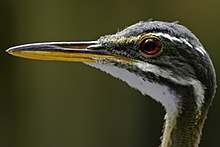Sunbittern
| Sunbittern | |
|---|---|

| |
| on Cristalino River Southern Amazon, Brazil | |
| Scientific classification | |
| Domain: | Eukaryota |
| Kingdom: | Animalia |
| Phylum: | Chordata |
| Class: | Aves |
| Order: | Eurypygiformes |
| Family: | Eurypygidae Selby, 1840 |
| Genus: | Eurypyga Illiger, 1811 |
| Species: | E. helias
|
| Binomial name | |
| Eurypyga helias (Pallas, 1781)
| |

| |
| Sunbittern range | |
| Synonyms[2] | |
| |
The sunbittern (Eurypyga helias) is a bittern-like bird of tropical regions of the Americas, and the sole member of the family Eurypygidae (sometimes spelled Eurypigidae) and genus Eurypyga. It is found in Central and South America, and has three subspecies. The sunbittern shows both morphological and molecular similarities with the kagu (Rhynochetos jubatus) of New Caledonia, indicating a gondwanic origin, both species being placed in the clade Eurypygiformes.[3]
Taxonomy
The sunbittern is usually placed in the
Subspecies
The sunbittern was formerly treated as two species (E. helias and E. major), but now they are treated as a single species with considerable variation between the
- E. h. helias (Pallas, 1781) – Amazonian sunbittern
- E. h. major Hartlaub, 1844 – northern sunbittern
- E. h. meridionalis Berlepsch & Stolzmann, 1902 – foothill sunbittern
Description

The bird has a generally subdued coloration, with fine linear patterns of black, grey and brown. Its
The sunbittern has a long and pointed bill that is black above, and a short
Distribution and habitat
The sunbittern's
The species is found in the humid
Behaviour and ecology


They are cryptic birds that display their large wings, that exhibits a pattern that resemble eyes, when they feel threatened.
Feeding
The sunbittern consumes a wide range of animal prey. Insects form an important part of the diet, with cockroaches, dragonfly larvae, flies, katydids, water beetles and moths being taken. Other invertebrate prey includes crabs, spiders, shrimps and earthworms. They will also take vertebrate prey including fish, tadpoles, toads and frogs, eels and lizards.[3]
Sunbitterns are one of 12 species of birds in five families that have been described as fishing using baits or lures to attract prey to within striking distance. This type of behaviour falls within the common definition of
Breeding
Sunbitterns start nesting in the early wet season and before it starts they make flight displays 10–15 m (33–49 ft) high in the forest canopy. They build open nests in trees, and lay two eggs with blotched markings. The young are

References
- . Retrieved 12 November 2021.
- ^ "Eurypyga helias (Pallas, 1781)". GBIF—the Global Biodiversity Information Facility. Retrieved 17 December 2017.
- ^ ISBN 84-87334-20-2
- ^ Houde et al. (1997) Phylogeny and evolution of 12S rDNA in Gruiformes (Aves). In: Mindell, D. P. (ed.), Avian Molecular Evolution and Systematics. Academic Press, San Diego. Pp. 121–158.
- PMID 26624624.
- ^ Fain & Houde (2004) Parallel radiations in the primary clades of birds Archived 7 April 2013 at the Wayback Machine. Evolution 58(11): 2558–2573.
- ^ Ericson et al. (2006) Diversification of Neoaves: Integration of molecular sequence data and fossils. Biology Letters 2 (4): pp. 543–547
- ^ Morgan-Richards et al. (2008) Bird evolution: testing the Metaves clade with six new mitochondrial genomes. BMC Evolutionary Biology 8 (20).
- ISBN 0-19-854012-4
- .
- ISBN 978-1-85391-186-6.
External links
- BirdLife Species Factsheet
- Sunbittern videos, photos & sounds on the Internet Bird Collection

